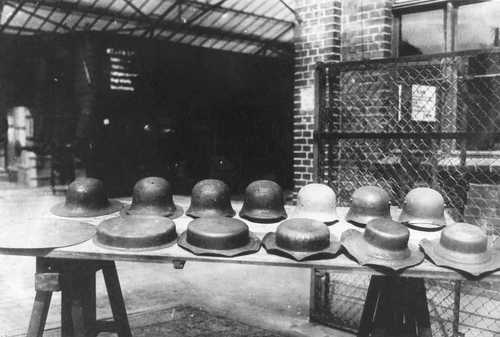
German Forces
Stahlhelm - manufacture.
Unknown (German) author.
Interesting photo, from WW1, of the stages of manufacture of the "shell" of the 1916 Stalhelm. The Germans were a little behind the curve as regards the development of helmets. All major combatants entered the war with their soldiers wearing soft headgear or, in the case of the Germans, the complex spiked helmets composed of a number of components and expensive ingredients - not involving steel. The great problem with all of this headgear was that it dod not provide adequate (or any) protection from a type of ammunition not previously encountered by anyone - fragmentation and shrapnel artillery shells exploding over the heads of troops, inflicting serious and often fatal head wounds. The French, followed quickly by the British, introduced steel helmets to counter this hazard. The Germans were not far behind them, commencing manufacture of the M1916 "Stahlhelm" early in 1916. With considerable detailed modification, this design was the origin of later (more compact) helmet types used by the Wehrmacht in WW2, as well as several types used by home protection and civil defense war in that war. It is obvious that the process of stamping these helmets was more obvious than, in particular, the British "Brodie" helmet that preceded it by a few months. However, while the "Brodie" was probably superior in supplying protection from shrapnel and fragmentation from above, the Stalhelm provided better protection overall. Best regards, JR.
3622 Views
8/20/2015
